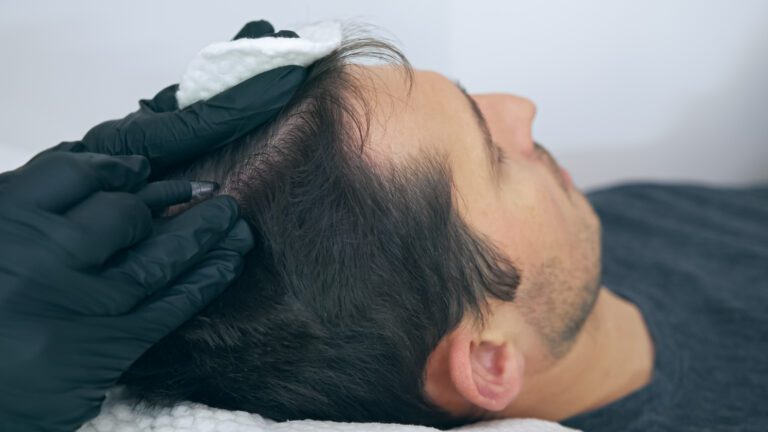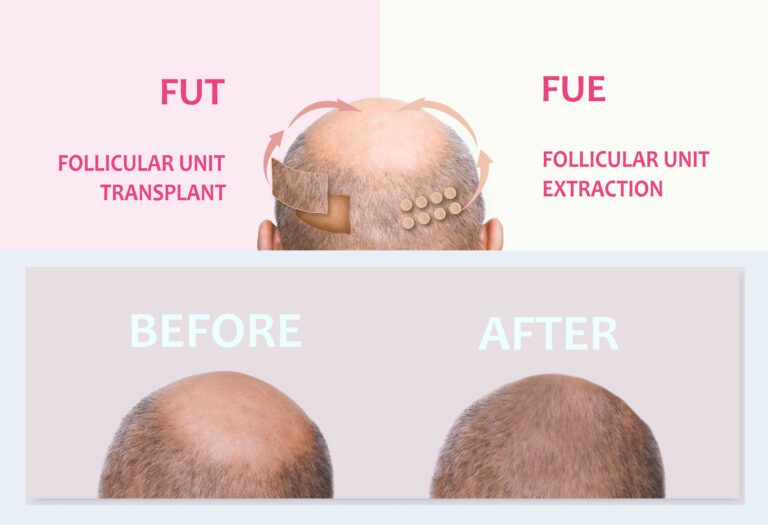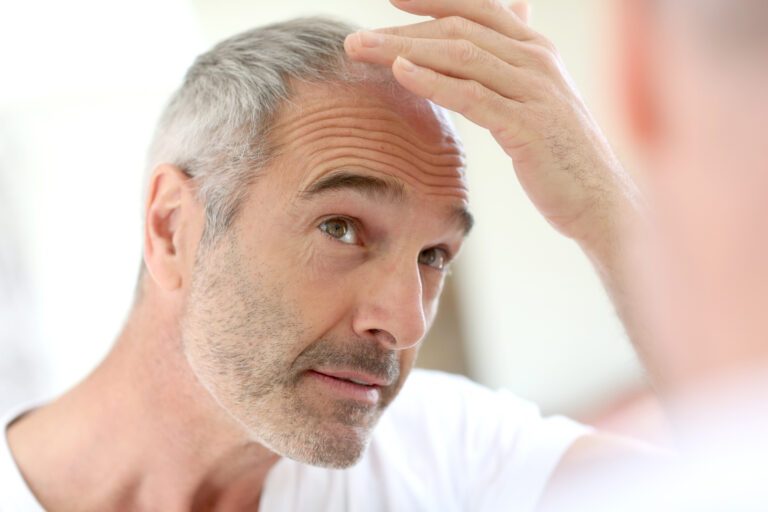Topical Finasteride: Can It Cause Serious Side Effects?
Topical finasteride is the alternative, physical application of its oral counterpart. Many doctors and finasteride users have praised this method of hair loss treatment.
Now, the question is, can it cause serious side effects?
Oral finasteride is known for potentially causing a few sexual-related issues if not taken properly. Let’s find out if its topical counterpart causes the same side effects, works similarly to a placebo, and is as effective.
What Is Topical Finasteride?
Topical finasteride is a common hair loss treatment, specifically for male pattern baldness (androgenetic alopecia), that’s been around since the late 90s. Finasteride is originally an orally-taken medicine developed in the 70s. However, the drug wasn’t approved by the Food and Drug Administration (FDA) to be used for androgenetic alopecia until 1998.
Similar to how the medicine works when taken orally, topical finasteride halts your body from producing dihydrotestosterone (DHT). The main difference is that you apply the topical solution directly to the hair follicles affected by hair loss.
You might also encounter recommendations for mixing finasteride with minoxidil to combat further and potentially reverse the effects of hair thinning. This method is also viable since minoxidil aids the effects of topical finasteride by allowing the solution to penetrate deeper into the hair follicles.
Despite not being approved by the FDA, the topical application of finasteride shows promising results. While it may not have the same level of effectiveness as the pills version, it still boosts hair count to a considerable degree.
How Does Topical Finasteride Work?
DHT is the number one culprit for causing androgenic alopecia. Not only does it shrink hair follicles, which causes male pattern baldness, but it also increases sebaceous gland activity. This hormone is also responsible for the following effects:
- Prostate growth
- Body hair development
- Facial and pubic hair growth
As much as some of the mentioned effects seem like benefits for the male body, too much DHT gives rise to hair loss and thinning. This is where finasteride comes in for the rescue. We know this medication under familiar brand names like Propecia and Proscar.
Finasteride works by inhibiting 5-alpha reductase through the prevention of testosterone converting into DHT. Since DHT is no longer needed as much when you get older, it’s best to keep it at bay by following a healthy lifestyle and taking finasteride as prescribed.
How to Use Topical Finasteride
Topical finasteride is applied directly to the areas where hair thinning is prominent. Since it takes a while for the scalp to absorb the solution, it’s best to use it at night before going to bed. That way, it’ll have ample time to take effect, and you can shower in the morning.
These are the steps to applying topical finasteride:
- Locate the affected areas on your scalp and spray the solution two to three inches away. You can also use a dropper or your fingers to specify the amount needed.
- When spraying in an area, be sure to part your hair in that location so the solution can reach the scalp better. Also, try not to go beyond the prescribed amount.
- Once you’ve applied the solution, gently massage your scalp to stimulate and spread it evenly.
- Wash your hands and let the scalp dry. Repeat the process once a day until your doctor says so.
What Are the Benefits of Topical Finasteride?
Topical finasteride comes with a lot of desirable benefits for those suffering from hair loss. While one of its main drawbacks is that it hasn’t been approved by the FDA yet, it shows great promise. The missing approval only means more thorough research and clinical trials are needed.
Nonetheless, we can’t deny that the topical use of finasteride is making waves in the medical field. Here are some of the remarkable benefits this form of finasteride has to offer:
- Helps reduce and possibly reverse the early stages of hair loss
- Has a 90% effectiveness rate in treating male pattern baldness
- Can be your first line of defense against hair loss before committing to a hair transplant
- Lessens the risks of side effects that come with orally taken finasteride
- Can easily be mixed with minoxidil to boost hair regrowth
Does Topical Finasteride Have Side Effects?
Like all medicinal treatments, topical finasteride comes with a few side effects. Yes, it’s not as bad as the pills version, but it still has some risks worth considering.
It’s worth noting that the results and side effects can always vary depending on the person using the medicine. If you’re planning to take topical finasteride, you should watch out and discuss the following side effects with your doctor:
- Scalp pruritus: Scalp pruritus, commonly known as itchy scalp, can occur if the area is sensitive to topical finasteride.
- Contact dermatitis: Contact dermatitis can be compared with the aftereffects of skin allergies, causing rashes on the scalp if it reacts negatively to the spray solution.
- Erythema: Erythema is another form of rash that causes redness and inflammation on the skin.
- Burning sensation and irritation: If your scalp is sensitive, it can experience irritation and a burning sensation when it comes in contact with topical finasteride.
- Lightheadedness and headaches: Finasteride headaches are common when taken orally, but they can also happen with topical application on rarer occasions.
- Oropharyngeal mucositis: Oropharyngeal pain refers to a significantly painful complication due to intensive chemotherapy and radiotherapy (head and neck).
- Conjunctivitis or pink eye: Conjunctivitis is the swelling of the conjunctiva, which can occur if the eye is exposed to topical finasteride.
Is Topical Finasteride Safe?
As much as we’ve just discussed the side effects of topical finasteride, the medication is generally safe to use. What we’ve enumerated on the list are merely potential consequences, and they don’t occur too often.
However, pregnant women shouldn’t use this medication, and neither should they come in contact with it if their husband uses it. In such cases, further consultation with your doctor is needed to devise an alternative treatment plan.
Additionally, you should also check first if you have any allergies or sensitivity to medications like minoxidil and finasteride. The best way to ensure your safety is by discussing your condition, medical history, and lifestyle with a trusted doctor before proceeding with the treatment.
How Much Does Topical Finasteride Cost?
Topical finasteride is a bit more costly compared to its oral counterpart. On average, you can spend around $20 to $60 or more, depending on which healthcare provider or pharmacy you’re purchasing from. Should the treatment last for at least a year or two, we’re looking at roughly $600 annually.
If you’re also considering minoxidil to boost topical finasteride’s efficacy, you might need to add around $15 to $20 per month. That’s an additional $200 per year of usage with topical finasteride.
Luckily, some healthcare providers offer monthly subscriptions to slightly reduce the costs of such treatment. Sometimes they even have discounted topical finasteride and minoxidil prices in a single subscription.
Can I Buy Topical Finasteride Over the Counter?
Unfortunately, topical finasteride is still unavailable for over-the-counter purchases due to the medication not being FDA-approved. While oral finasteride proves to be effective for hair loss issues and has been approved since 1997, clinical trials are ongoing for topical application.
Can You Use Oral and Topical Finasteride at the Same Time?
Yes, it’s possible to use both oral and topical finasteride at the same time to treat androgenic alopecia. However, you need a physician’s prescription first before you’re allowed to take them.
While it can definitely boost hair regrowth and prevent hair loss from worsening, the potential side effects of taking both at once can be too much to handle. You have to confirm with your doctor if combining oral and topical finasteride will work with your condition and medical history.
Does Topical Finasteride Go Systemic?
One of the best things about topical finasteride is that it doesn’t go systemic. It can decrease DHT levels by directly targeting the affected hair follicles on your scalp, unlike its oral version, which diffuses throughout the body.
Since you only need to apply the solution spray on the area where hair thinning is prominent, there are little to no side effects most of the time. You don’t have to worry about potential sexual-related consequences brought about by the systemic intake method.
However, since topical finasteride still comes in contact with your scalp, skin-related irritations and reactions can occur. Additionally, the topical way of application has a decreased rate of absorption compared to the placebo.
Wrapping Up
Despite the popularity of topical finasteride, scientists need more data to confirm its efficacy and other possible side effects. At the very least, even if it isn’t FDA-approved yet, it still shows favorable results thus far.
Hair loss is a common issue among males, especially those who are pushing their 30s and above. That’s why DHT levels should be regulated the older we get.
If topical finasteride gets approved, the more accessible it’ll become for men suffering from male pattern baldness. Not only will it help with such conditions, but also with lesser risks of unwanted sexual side effects.







